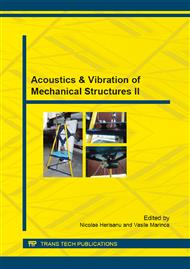p.129
p.136
p.142
p.148
p.154
p.159
p.165
p.171
p.176
The Dynamic Response of the Elastomeric Isolators Modeled as Voigt-Kelvin to the Action of the Seismic Motion
Abstract:
The paper presents the model of a seismic mass with viscoelastic linear connections, following the Voigt-Kelvin model, with the fundamental unidirectional harmonic kinematic excitation of an earthquake. The motion is caused by seismic action. Thus, the parameters and the motion laws of the mass, the inertial force and the force transmitted to the fixed base are determined. Also, the relations for the amplitude and the transmissibility of the motion are established in function of the elastic and viscous parameters of the composed model Voigt-Kelvin.Based on the established relations the dissipated energy function of the acceleration of the earthquake and of the dominant pulsation and the viscoelastic characteristics are determined.
Info:
Periodical:
Pages:
154-158
Citation:
Online since:
October 2015
Authors:
Keywords:
Price:
Сopyright:
© 2015 Trans Tech Publications Ltd. All Rights Reserved
Share:
Citation:


